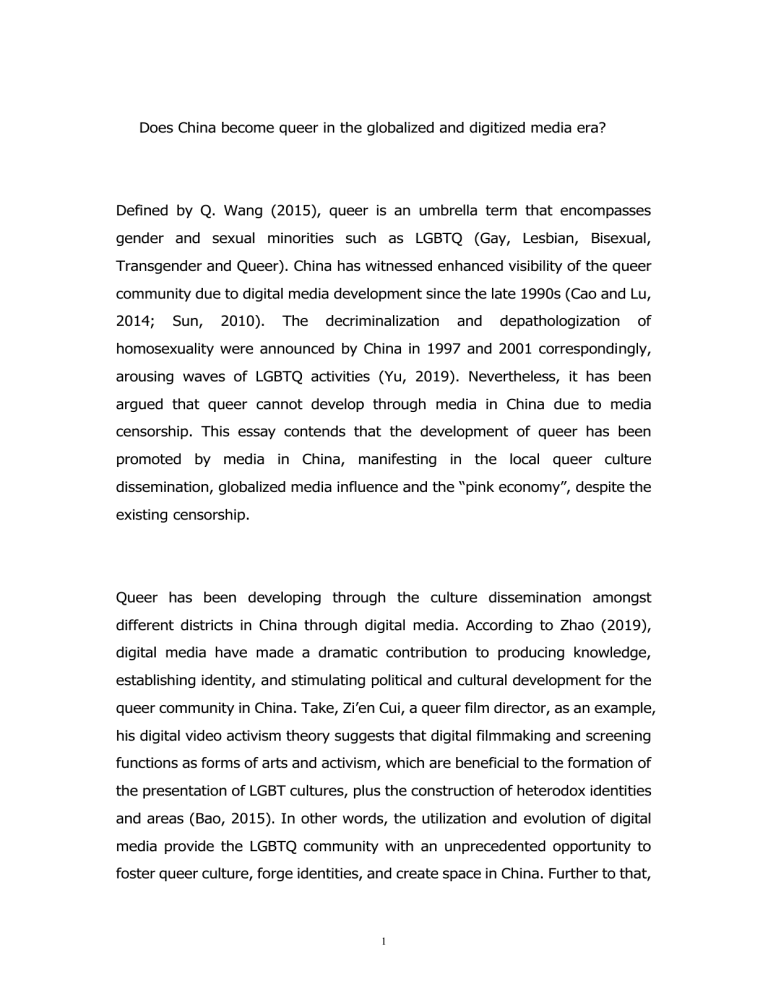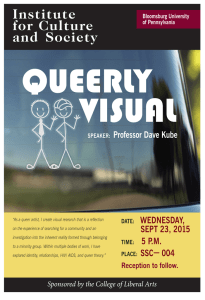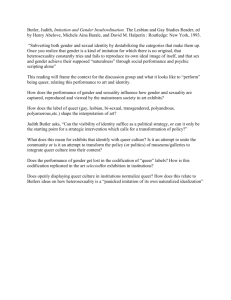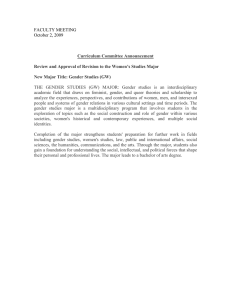
Does China become queer in the globalized and digitized media era? Defined by Q. Wang (2015), queer is an umbrella term that encompasses gender and sexual minorities such as LGBTQ (Gay, Lesbian, Bisexual, Transgender and Queer). China has witnessed enhanced visibility of the queer community due to digital media development since the late 1990s (Cao and Lu, 2014; Sun, 2010). The decriminalization and depathologization of homosexuality were announced by China in 1997 and 2001 correspondingly, arousing waves of LGBTQ activities (Yu, 2019). Nevertheless, it has been argued that queer cannot develop through media in China due to media censorship. This essay contends that the development of queer has been promoted by media in China, manifesting in the local queer culture dissemination, globalized media influence and the “pink economy”, despite the existing censorship. Queer has been developing through the culture dissemination amongst different districts in China through digital media. According to Zhao (2019), digital media have made a dramatic contribution to producing knowledge, establishing identity, and stimulating political and cultural development for the queer community in China. Take, Zi’en Cui, a queer film director, as an example, his digital video activism theory suggests that digital filmmaking and screening functions as forms of arts and activism, which are beneficial to the formation of the presentation of LGBT cultures, plus the construction of heterodox identities and areas (Bao, 2015). In other words, the utilization and evolution of digital media provide the LGBTQ community with an unprecedented opportunity to foster queer culture, forge identities, and create space in China. Further to that, 1 for instance, the local lesbian app Butterfly in Hong Kong (Tang, 2016 ), the Chinese BBS (bulletin board system) and feminist and lesbian journal G-zine in Taiwan (Sang, 2003 ), and the online lesbian magazine Les+ in mainland China (Zhao, 2019) contribute to an expansive queer culture circulation collectively. To summarize, queer culture dissemination has been fostered by digital media throughout China, which develops queer ultimately. In parallel with local queer culture circulation, globalized media dramatically accelerates the growth of queer in China by introducing Danmei genre media and global media platforms and tools. Danmei (耽美), defined by Wong (2020), is an imported word derived from Japanese, featuring Boy’s Love (BL) genre media. BL genre media has inflated the queer visibility and the imagination of queer culture in China (Yu, 2019; Zhao, 2020). To illustrate, plentiful BL cyberliterature is circulated and adapted into dramas or films, depicting queer identity and bringing overwhelming passion among especially women in China (Zhao, 2020; Wong, 2020; Ng & Li, 2020). Additionally, the globally accessible media platforms and tools multiply the convenience of transmitting global queer culture to China, which can be exemplified by YouTube and Virtual Private Networks (VPN) respectively. YouTube, a global video website, helps distribute global queer videos in China, where queer media is forbidden (Zhao, 2019). Moreover, Zhao (2019) states that VPN breaches the political information blackout in China, enabling the Chinese to access global media culture. In conclusion, Chinese queerness has thrived through imported BL media, media platforms and tools. 2 Aside from local queer culture propagation and globalized media influence, the emerging pink economy has favored queer development in China, embodying in dating apps and queerbaiting in commercial media. In accordance with the Collins Dictionary of Sociology (D. Jary & J. Jary, 2000), pink economy features businesses, services and commercial media targeted at queer groups. Investigated by S. Wang (2019, 2020), Blued, a profitable gay-dating app in China, is a magnificent example of flourishing in urban areas and e-commerce merchandising sphere, thus providing mass online space for the queer community. Furthermore, the commercial application of queerbaiting in more dramas or films, whose purpose is to attract more audiences and therefore create more economic benefits, to some extent, increases the visibility of queer and develops queer eventually. As Ng and Li (2020) explain, queerbaiting occurs when audiences are implicitly imbued with the illusion that two same-sex characters are involved with romantic relationships. For example, Guardian, a popular BL-adapted TV drama, portraying the romantic relationship between the male characters obscurely, not only evoked fans’ enthusiasm to pay for it but also drew public attention to queer (Ng and Li, 2020). To conclude, pink economy is contributing to the development of queer in China. While someone believes that media boosts the development of queer in China, others dispute that media will not help queer thrive in China because of queer media censorship, which prevents queer culture from being circulated. Numerous examples can validate the censorship. In 2018, the Chinese singing competition Eurovision erased scenes depicting gay romance; A rainbow flag on the stage, which symbolizes LGBTQ pride, was blurred on the screen (Zhao, 2018). Likewise, in 2018, the Guardian series was unexpectedly taken down and a multitude of scenes intimating homosexuality had been deleted or 3 modified after the series was available again (Ng and Li, 2020). However, this censorship will hardly eliminate queer media due to its ambiguity and BL fans’ self-censorship. Zhou (2017) concludes that queer censorship is ambiguous and difficult to apply since it does not clarify the criteria of defining and classifying queer media, thus allowing media to reveal queer implicitly. Moreover, BL fans have developed self-censorship to negotiate with the censorship system by catering to the “Core Socialist Values” concerning Chinese political directions, pretending that the male-male romance is “socialist brotherhood’’ (Ng and Li, 2020). That is to say, their self-censorship protects the queer media from being banned and queer media censorship cannot prevent them from imagining the BL romance and circulating queer culture implicitly. In summary, media has promoted queer development in China. Queer culture is disseminated among various districts in China supported by digital media. As BL genre media, global media platforms and tools such as YouTube and VPN are introduced to China, queer has flourished rapidly. Pink economy also helps promote queer by producing online space and propagating queer culture. Although someone argues the media censorship is a thorny hindrance, the ambiguous regulation and fans’ self-censorship allow queer culture to develop implicitly. It is predicted that China will embrace queer in the near future. Reference (APA) 4 Bao, H. (2015). Digital Video Activism: Narrating History and Memory in Queer China, ‘Comrade’ China. In E. L. Engebretsen and W. F. Schroeder (Eds), Queer/Tongzhi China (pp. 35-56). Copenhagen: NIAS Press. Cao, J. & Lu, X. (2014). A Preliminary Exploration of the Gay Movement in Mainland China: Legacy, Transition, Opportunity, and the New Media. Signs, 39(4), 840-848. doi:10.1086/675538 Jary, D. & Jary, J. (2000). Collins Dictionary of Sociology. (3rd ed.) New York: HarperCollins. Ng, E. & Li, X. (2020). A queer “socialist brotherhood”: the Guardian web series, boys’ love fandom, and the Chinese state. Feminist Media Studies, 20(4), 479-495. doi:10/14680777.2020.1754627 Sang, T. D. (2003). The Emerging Lesbian: Female Same-Sex Desire in Modern China. Chicago: University of Chicago Press Sun, Z. (2010). Speaking out and space-making: The emergence of gay identities and communities in China. In P. Stoltz, M. Svensson, Z. Sun, & Q. Wang (Eds.), Gender equality, citizenship and human rights: Controversies and challenges in China and the Nordic countries (pp. 99-115). London, UK: Routledge. 5 Tang, D. T. S. (2016). Essential Labels? Gender Identity Politics on Hong Kong Lesbian Mobile Phone Application Butterfly. In L. Hjorth and O. Khoo (Eds.), Routledge Handbook of New Media in Asia (pp. 263-274). Abingdon, UK: Routledge Wong, A. K. (2020). Towards a queer affective economy of boys’ love in contemporary Chinese Continuum, media. 34(4), 500-513. doi:10.1080/10304312.2020.1785078 Wang, Q. (2015). Queerness, Entertainment, and Politics: Queer Performance and Performativity in Chinese Pop. In E. L. Engebretsen and W. F. Schroeder (Eds), Queer/Tongzhi China (pp. 153-178). Copenhagen: NIAS Press. Wang, S. (2020). Calculating dating goals: data gaming and algorithmic sociality on Blued, a Chinese gay dating app. Information, Communication & Society, 23(2), 181-197. doi:10.1080/1369118X.2018.1490796 Wang, S. (2019). Chinese affective platform economies: dating, live streaming, and performative labor on Blued. Media, Culture and Society, 42(4), 502-520. doi:10.1177/0163443719867283 6 Yu, Y. (2019). Lush Grass, Regrows in Spring: Queer Lala Times as Feminist and Queer Media in China. China Media Research, 15(2), 19-28. Zhou, E. L. (2017). Dongfang Bubai, Online Fandom, and the Gender Politics of a Legendary Queer Icon in Post-Mao China. In M. Lavin, L. Yang, and J. J. Zhao (Eds.), Boys’ Love, Cosplay, and Androgynous Idols: Queer Fan Cultures in Mainland China, Hong Kong, and Taiwan (pp. 111-127). Hong Kong: Hong Kong University Press. Zhao, J. J. (2020). It has never been “normal”: queer pop in post-2000 China. Feminist Media Studies, 20(4), 463–478. doi:10.1080/14680777.2020.1754626 Zhao, J, J. (2019). New Media in Asia. In H. Chiang (Ed.), Global Encyclopedia of Lesbian, Gay, Bisexual, Transgender, and Queer History (pp.1142-1147). New York: Charles Scribner’s Sons. Zhao, J. J. (2018, June 1). Censoring ‘Rainbow’ in China. Retrieved from: https://theasiadialogue.com/2018/06/01/censoring-rainbow-in-china/ 7




